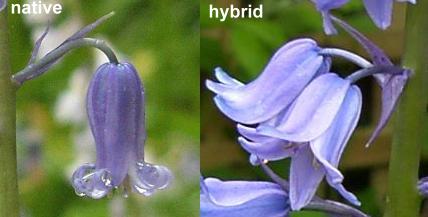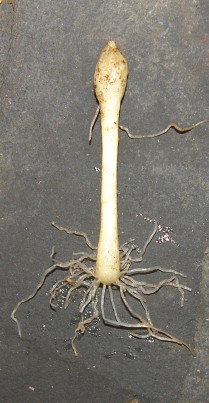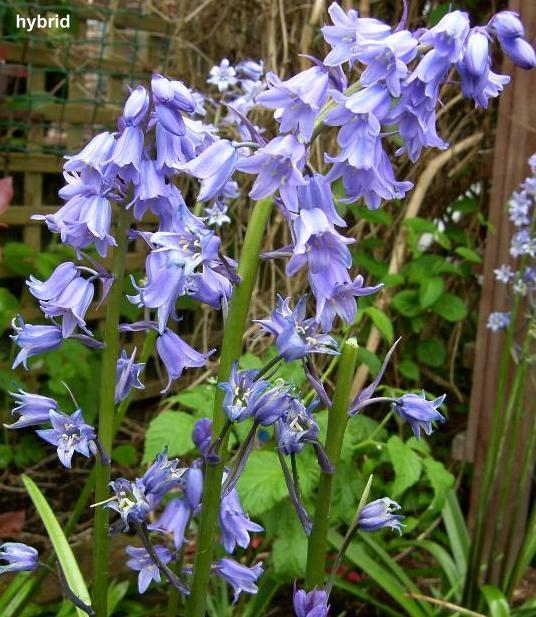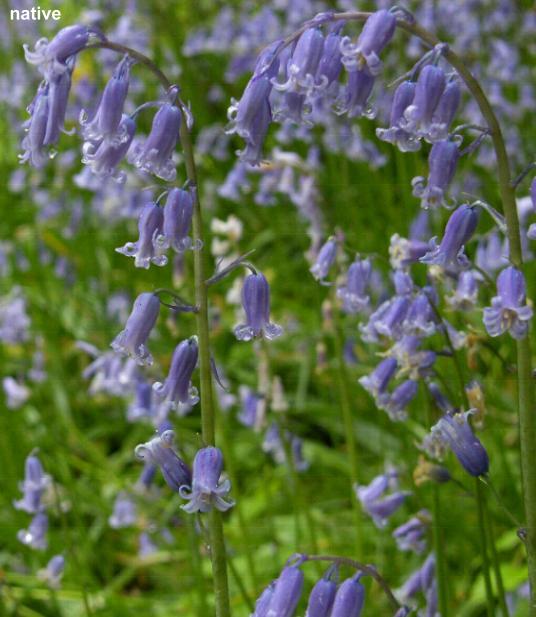Hybrid BluebellScientific Name: Hyacinthoides x massartiana |
The classic view of a woodland carpeted in Bluebells is what most people like to see in late spring, but there are concerns that the native species could be lost to the more vigorous Spanish one, Hyacinthoides hispanica or the Hybrid form which results from cross-pollination. H. hispanica was introduced as a garden plant but has escaped and is now established in the wild along with the Hybrid H. x massartiana, which is probably more common.
They spread by seed and multiplication of the bulbs. Also care should be taken when moving plants from an area in the garden where they are present which could have bulbs in the root-ball.
Identifying Native and Hybrid Bluebells
It is quite easy to distinguish the Native Bluebell, H. non-scripta from the Spanish form by the broader leaves, the different shape of the flowers and the lack of scent from the latter. In both the flowers are borne in racemes, but on H. hispanica the spike is upright with individual flowers arranged around the stem, whereas it droops over in the Native one with the flowers to one side. Also the shapes of the individual flowers differ, the petals are shorter and form an open bell on the Spanish Blubell; those on the Native ones are longer forming a straighter tube and are rolled back at the tip.The Hybrid forms are somewhere in between the other two with more of the Spanish Bluebell characteristics, ie. broader leaves, little scent and flowers all around the stem which can droop slightly to one side. The petals are shorter and more open at the end similar to the Spanish form, but the tips are rolled back to varying degrees.

The anthers are creamy-white in H. non-scripta, pale creamy-blue in H. x massartiana and clear, mid-blue in H. hispanica.

It can be difficult to remove unwanted Hybrid or Spanish Bluebells using cultural methods as the bulbs are easily missed when digging. Also if the flowers have matured there will be seed present which will germinate later. The best time to tackle them is when they start to grow in the spring time, when it is possible to follow the leaves down to the bulbs (if the type has been identified in earlier years). This will probably have to be repeated later as seed germinate or surviving bulbs re-emerge.
They can be quite deep down as the bulbs have a mechanism to lower themselves. When the seed germinate the small bulblets that develop are at the surface, but as they grow larger they elongate reforming lower down (pictured left).
Weedkillers to use:-
Glyphosate is a systemic which is taken down to the bulb and would probably work best after flowering when the plant is building up the bulbs; the flowers should be removed to prevent the formation of seed. The treatment would need to be repeated on any seedlings which might germinate later and can be used as a follow-up treatment after digging up most of the bulbs.
Rarer pinkish or white forms can occur and the latter can sometimes be mistaken for the Three-cornered Leek.
Follow these links for further details on Weeds, Weed Removal and Weed Prevention.

